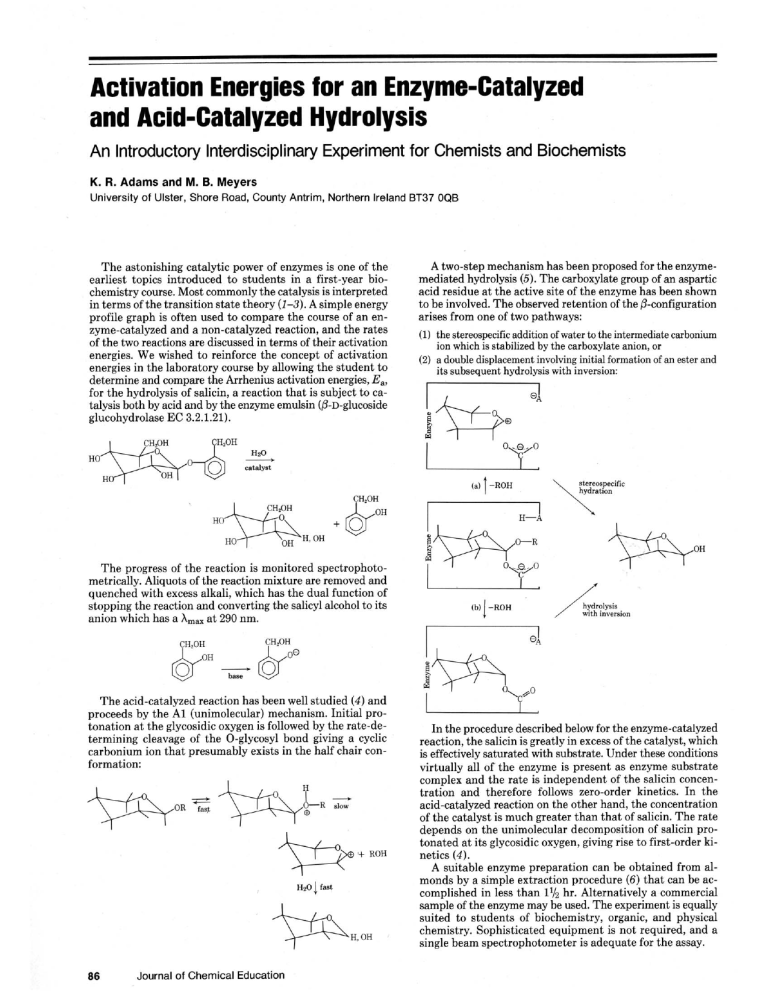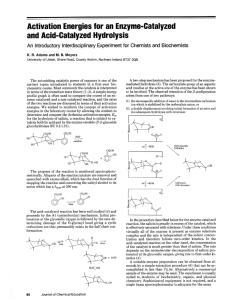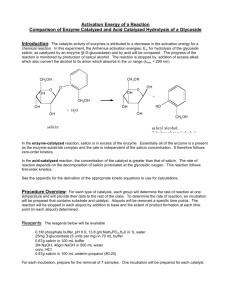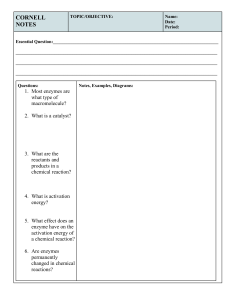Enzyme & Acid Hydrolysis Activation Energies
advertisement

Activation Energies for an Enzyme-Catalyzed and Acid-Catalyzed Hydrolysis An Introductory Interdisciplinary Experiment for Chemists and Biochemists K. R. Adams and M. B. Meyers University of Ulster, Shore Road, County Antrim, Northern Ireland BT37 0QB The astonishing catalytic power of enzymes is one of the earliest topics introduced to students in a first-year bioc h e m i s t ~course. Most commonly the catalysis is interpreted in terms bf the transition state theory (1-3).Asimple energy profile nraoh is often used to compare the course of an enzyme-c&dyzed and a non-catalyzed reaction, and the rates of the two reactions are discussed in terms of their activation energies. We wished to reinforce the concept of activation energies in the laboratory course by allowing the student to determine and compare the Arrhenius activation energies, E., for the hydrolysis of salicin, a reaction that is subject to catalysis both by acid and by the enzyme emulsin (P-D-glumside glucohydrolase EC 3.2.1.21). A two-step mechanism has been proposed for the enzymemediated hydrolysis (5). The carboxylate group of an aspartic acid residue a t the active site of the enzyme has been shown to be involved. The observed retention of the 8-configuration arises from one of two pathways: (1) the stereospecific addition of water to the intermediate carbonium ion which is stabilized by the carboxylate anion, or (2) a double displacement involving initial formation of an ester and its subsequent hydrolysis with inversion: The progress of the reaction is monitored spectrophotometrically. Aliquots of the reaction mixture are removed and quenched with excess alkali, which has the dual function of stopping the reaction and converting the salicyl alcohol to its a t 290 nm. anion which has a A,., The acid-catalyzed reaction has been well studied (4) and proceeds by the A1 (unimolecular) mechanism. Initial protonation a t the glycosidic oxygen is followed by the rate-determining cleavage of the O-glycosyl bond giving a cyclic carbonium ion that presumably exists in the half chair conformation: In the procedure described below for the enzyme-catalyzed reaction. the salicin is ereatlv in excess of the catalvst, which is effecti;ely saturatedkth substrate. Under these eoiditions virtually all of the enzyme is present as enzyme substrate complex and the rate is independent of the salicin concentration and therefore follows zero-order kinetics. In the acid-catalyzed reaction on the other hand, the concentration of the catalvst is much ereater than that of salicin. The rate depends on the unimolecular decomposition of salicin protonated at its glycosidic oxygen, giving rise to first-order kinetics (4). A suitable enzyme preparation can be obtained from almonds by a simple extraction procedure (6)that can be accomplished in less than 11/2 hr. Alternatively a commercial sample of the enzyme may be used. The experiment is equally suited to students of biochemistry, organic, and physical chemistry. Sophisticated equipment is not required, and a single beam spectrophotometer is adequate for the assay. ~~ 86 Journal of Chemical Education ~~ Experimental The whole exneriment takes about 4 hr. hut this time can be halved by having students do either the acid- or the enzyme-catalyzed reaction and exchange their data. The following quantities are sufficient for a group of 12 students. Emulsin t m e I11 (5 units per ma) -. was obtained from the S i m a ~hemical?omp&y. Enzyme-Catalyzed Reaction Solutions of emulsin (0.025g) in 70 ml of 0.1 M phosphate huffer. pH 6. and of salicin (0.67 gJ in I(X1ml of the same huffer are equally diwded mtoreaeent bottlesand dared in :lO°C and 40°C water baths and allowed takauilibrate at the start of the class. Each student prepares a set of 14 numhered test tubes containing 10 ml of 1 .U NaOH. Theenzyme reaction is started by mixing 7.5 ml of rhesal~c~n and 2.5 ml of the emulsin solutions in a boilma tube at one of the two temperatures and the time is noted. A 0.3-ml sample is removed immediately and dispensed into the first test tuhe. Thereafter, 0.3-ml aliquots are removed at intervals of 3 min until a total of seven test tubes has been used. The entire procedure is repeated at 40DCusing the remainine seven test tubes. The ootical densitv at 290 nm of all the tuhen is read aeainst ,.~ a hlank of 1.6 ml of sodium hvdroxide and 2.5 ml vf distilled u,ater. The 7ero-orderrateronstnnts for each temperature are ohmined by plotting the optical density against tlme (see Fig. 1). The slope of the straight line obtained during the initial stages is the zero-order rate constant. ~ ~~~~ ~~ ~~ ~ ~~ ~~ ~~~ ~~ I L I I5 W 20 "3- Figure 1. Zerwrder plot for the enzymecatalyzed reaction at 30% and 40%. ~ Acid-Catalyzed Reaction A solution of salicin (0.67 g) in 100 ml of solution containing 80% water and 20%I-propanol is divided between two water baths at 65'C and 75°C and allowed to equilibrateas before. Aset of 15 numbered test tubes containing sodium hydroxide L prepared as described ahove. The reaction is started by mixing 7.5 ml of the salicin solution and 2.5 ml of concentrated hydrochloric acid in a lightly covered boiling tube in the bath at 65%. Aliquot8 of the reaction mixture are removed and quenched as before except that 5-min intervals are necessary due to the jluwer rate of reaction. The a hole procedure is repeated at 7 P C using thp next 7 teit tuhes, withdrarvingsamplesat 3-mm intervals. Finah. the rpactim flask is laced in a hoiiine water bath for 15 min to oht& awholly hydrolyz;d sample. 0.3 miof this solution is removed and placed in the last test tuhe. The first-order rate constants are obtained by subtracting all the optical density readings at each temperature from that of the fully reacted sample and plotting the logarithm of the resulting values against time (see Fig. 2). With careful planning the sampling can he speeded up by performing reactions at two temperatures simultaneously and interspersing sample withdrawals. Results and Dlscusslon The energy of activation E, for the enzyme and acid-catalyzed hydrolyses can he readily calculated from the following form of the Arrhenius equation: where ko and k , are the rate constants a t the unner .. and lower temperitures, and TI, respectively. Values ohtained for E, were around 25 kcaVmole for theacid-catalyzed hydrolysis and 6 kcabmole for the enzyme-catalyzed reaction. The latter value is typical of artivation energies reported for diffusioncontrolled reactions in water (7), thus the effidencyofemulsin as a catalyst is probably underestimated when present at the concentration used in the procedure described ahove. However, the experimentally determined values clearly demonstrate the remarkable effect of the enzyme on the activation energy. T h e values of artivation energies obtained in this experiment are in broad agreement with early published data for these reactions (8)and are consistent with data for the acid hydrolysis of other glucopyranosides ( 4 ) and with the artivation energies for other rnzyme-catalyzed reactions (8-12). Students have consisrentlv obtained plood resulrs. Accuracv in maintsining the temperature of thekater baths and in thk removal of samnles was i m ~ o r t a nfor t consistent results. We would recommknd the use of an automatic pipet for this T2 0.4 0 I0 20 ,NN I0 Figure 2. First-order plot of the acid-catalyzed reaction at 65% and 75'C purpose. Thorough mixing of the quenched samples was also essential. The chore and inaccuracy of plotting kinetic data can he removed by the application of a least squares linear regression analysis computer program. It is important to emphasize that the Arrhenius activation energy (E.) takes no account of entropy effects. A useful extension of this experiment would be the calculation of the entropy ( A S ) and other activation parameters from the rate constants using the expression (13) k = -ekT .e~S1/R h .e-EJRT where k and h are, respectively, Boltzmann's and Planck's constants. Using the standard relationship A@ = AH%- T A S and E.=AH%+RT the free energy ( A c t ) and enthalpy (AH') of activation can be readilv obtained. In most cnses the values of AH' and AS: are suchihat ACI does not vary greatly for widely different enzvmic reactions. Thus, if AH' is larre for a varticular enzyme reaction the value of AS%will t e i d to be iarge and positive whereas if AH%is small then AS' will he negative. Unfortunately, i t is often not made clear in textbooks which acVolume 62 Number 1 January 1985 87 tivation energy, AGI, AH$, or E,, is referred to in graphs depicting energy profiles of enzyme-catalyzed reactions. Literature Cited ( I ) Conn,EricE.,snd Sturnpi, P. K.,"OutlinerafBiochemistry," 4th ed., John Wileysnd 1 Sons Ine., New York. 1976, p. 168. (2) Suttic, John W.,"lntmdmdmdtiii taBiahemistry,"2nded.,H~lt,Ri~ehanand Winiton, NewYork. I977.p. 153. (3) Lehninger,AlbertL.."Bioehemistry,"2nded., WorthPublishihemInc.,NawYorh,1975. p. 183. 88 Journal of Chemical Education (4) Armour,C., Buntan. C.A., Patai, 8.. Selman, L. %and Vernon, C. A..J Chem Soe., 412119611. ( 5 ) Legler. G., Aeto Micwbiol. Acad. Sei. Hung.,22,403 (1915). I61 Mann.F. G..andSsunden,B. C.."PrscticalOreanicChemiaW."4thed.,Longmans, London,1960.p 513. (7)Levenson, G. I. P . , J Photogr. Sei.. 10.280 (1962). I81 Steam. A. E., Erg& Emymlorach., 7,1(19381, and referenced therein. (9) Lineweaver. H., J. Amer Chem. Soc.. 61,403 (19391. !., (1966). (10) T ~ OJ. A,, ~ J~ ~,h e o r e ~ ~ i o19,297 (11) Roberts,D. V.,and Elrnore,D.T.,Biochem. J.. 141.545 (19741. (12) Miller, J. F., and Cory, J. G., J. CHBM. EDuc., 48,485 (1971). (13) Laidler, K. J.."Chemid Kinetics,"2nd ed.,Mffiraw-Hill BwkCo.. NslaYorl p. 90.




